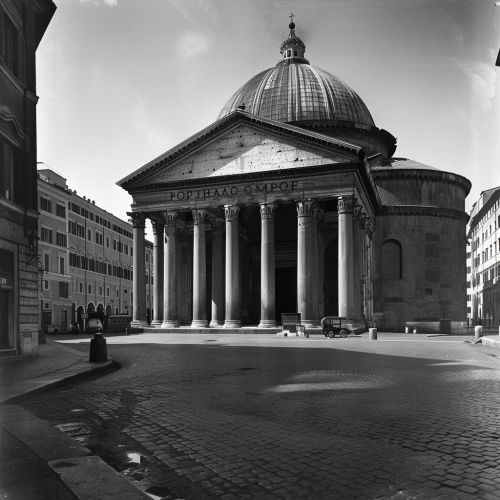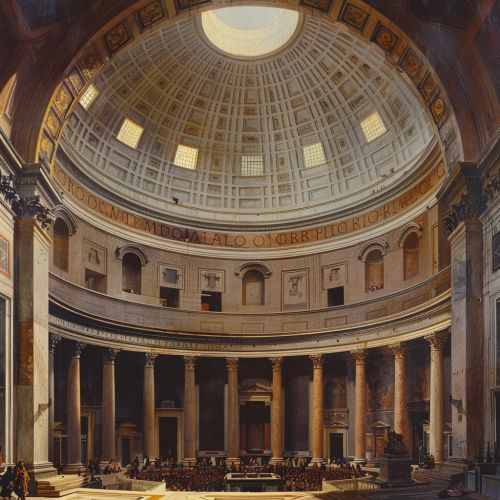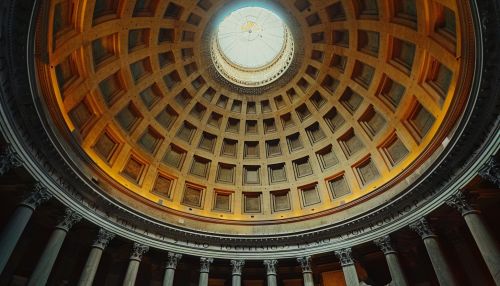Pantheon, Rome
Architecture
The Pantheon is a former Roman temple, now a church, in Rome, Italy, commissioned by Marcus Vipsanius Agrippa during the reign of Augustus (27 BC - 14 AD). It was completed by the emperor Hadrian and probably dedicated about 126 AD. Its date of construction is uncertain, as Agrippa's original Pantheon burned down in 80 AD. It was rebuilt by the emperor Domitian, but was struck by lightning and burned again in 110 AD.


The Pantheon's dome is still the world's largest unreinforced concrete dome. The height to the oculus and the diameter of the interior circle are the same, 43.3 metres (142 ft). It is one of the best-preserved of all Ancient Roman buildings, in large part because it has been in continuous use throughout its history and, since the 7th century, the Pantheon has been in use as a church dedicated to "St. Mary and the Martyrs" (Latin: Sancta Maria ad Martyres) but informally known as "Santa Maria Rotonda". The square in front of the Pantheon is called Piazza della Rotonda.
History
The Pantheon was originally built as a temple to all gods. The temple was a rectangular building, built by Marcus Agrippa, son-in-law of Augustus, the first Roman emperor, in 27-25 BC. It was destroyed along with other buildings in a huge fire in 80 AD. The emperor Domitian rebuilt the Pantheon, but it was struck by lightning and burned again in 110 AD.
The Pantheon was completely rebuilt by the emperor Hadrian in about 126 AD. The building that stands today was actually the third Pantheon on this site. The inscription on the front of the building, which reads "M·AGRIPPA·L·F·COS·TERTIVM·FECIT," is a tribute to Agrippa and means "Marcus Agrippa, son of Lucius, made [this building] when consul for the third time."
Design
The design of the Pantheon is a synthesis of traditional Greek and Roman architectural elements. The Greek influence is seen in the Corinthian columns of the portico and the triangular pediment. The Roman elements include the dome, the use of concrete, and the incorporation of the porch into the rotunda. The Pantheon's design has influenced countless buildings throughout history, across Europe and the Americas.
The Pantheon consists of a large circular portico with three ranks of huge granite Corinthian columns. The portico opens into a rotunda which is topped with a concrete dome with a central opening (oculus) to the sky. Almost two thousand years after it was built, the Pantheon's dome is still the world's largest unreinforced concrete dome.


The Dome
The dome of the Pantheon, at 43.3 metres (142 ft) diameter, holds the record for the largest unreinforced concrete dome in the world. The thickness of the dome varies from 6.4 metres (21 ft) at the base of the dome to 1.2 metres (3.9 ft) around the oculus. The materials used in the concrete of the dome also varies. At the thickest part, the aggregate is travertine, then terracotta tiles, then at the very top, tufa and pumice, both porous light stones.
The upper part of the dome is decorated with five rows of 28 coffers which reduce in size as they ascend towards the central opening or "oculus". The oculus at the top of the dome was never covered, allowing rain and natural light to enter the rotunda below.
Influence
The Pantheon has been a source of inspiration for many buildings and structures throughout the centuries. Its dome was the largest in the world until the completion of the Florence Cathedral in the 15th century. The design of the Pantheon was adopted in Western architecture in a variety of ways, becoming standard practice in the Catholic Church and later also in Protestant ecclesiastical architecture. Numerous city halls, universities and public libraries echo its portico-and-dome structure.
Present Day
Today, the Pantheon is a major tourist attraction in Rome with thousands of visitors every year. It is also used for Catholic ceremonies and the occasional wedding. It is the burial place of several important Italians (notably the artist Raffaello Sanzio da Urbino, known as Raphael), and it remains an active church. It is also the site where the Italian kings Vittorio Emanuele II and Umberto I, as well as Umberto's Queen, Margherita, are buried.
